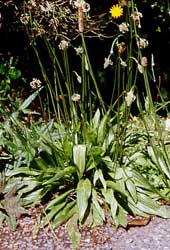Learn 
- Weed identification
- Weed control
- Weed management
Weed control is an important part of the horticulturists daily routine - irrelevant of which sector you are working in ie. greenhouse growing, open field growing, pot culture, or gardens you will need to be able to identify weeds and chose an appropriate control technique.
In horticultural practice, if weeds are to be controlled, it is critical that they are accurately identified when young. However, weeds are notorious for their diversity and resilience. These two characteristics have made weeds attractive as garden plants in countries to which they are not native.
Young weeds are far easier to control than older and more established weeds. There are many different ways of controlling weed growth, and the effectiveness of each technique is related to the varieties of weeds being controlled. Some chemicals, for instance will effectively kill certain weeds when they are in the early stages of growth, but will not control other types of weeds. You may need to be able to distinguish between types of weeds to determine whether the chemical will or will not work.
Over eight lessons you learn about both chemical and non-chemical control methods (mulching, burning, mowing), the use of spray equipment and safety procedures which should be followed.